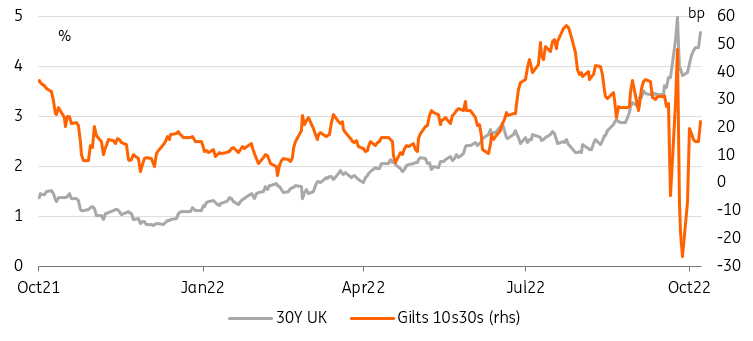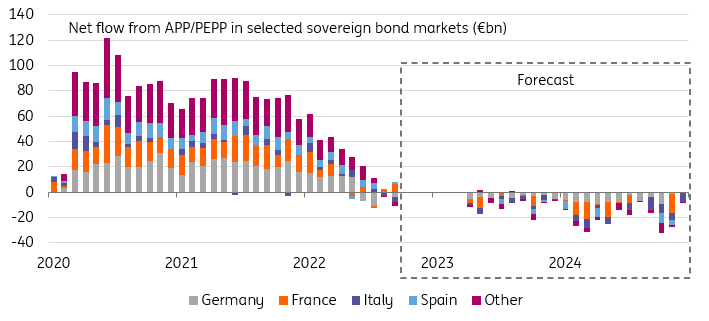The approaching end to the Bank of England’s purchases has sent gilts into a tailspin, a repo facility would help deal with margin financing but won’t solve the underlying problem. Joint EU debt issuance could compound fears of a more hawkish European Central Bank
The end of BoE gilt buying looms large
The Bank of England (BoE) tried – and failed – to reassure markets about the end of its gilt-buying program on October 14. Despite a greater buying capacity of £10bn at each of the remaining operations, offers were limited and the BoE only managed to buy less than £1bn on Monday. The underlying concern is that even as its intervention draws to a close, not enough deleveraging has been achieved by pension funds, and that another wave of forced selling will emerge into next week.
Volatility could well force the BoE back to the gilt market, maybe as early as today
As the BoE itself has said, the aim of the buying facility was to buy pension funds time to shore up their liquidity position. Concerns remain about whether the last week-and-a-half was enough to achieve this in distressed market conditions. Eventually, the gilt sell-off could force the BoE back into the market. As we wrote at the time, we think a longer period of support for gilts will be necessary to restore market confidence. 30Y gilts traded at 4.7% yesterday, just 30bp below their pre-intervention peak, and their weakness dragged the pound lower. Volatility could well force the BoE back to the gilt market, maybe as early as today. And indeed, the Bank just announced that it will extend its purchases to inflation-linked gilts, adding one buying operation of up to £5bn each day this week to the already scheduled conventional gilt purchases.
Helpfully, the announcement came alongside the launch of a repo facility accepting a broader range of assets as collateral. The idea is that instead of being forced sellers of, say, corporate bonds due to growing margin requirements, pension funds could instead pledge them as collateral to obtain financing. The facility will be in place for one month. In our view, this should be viewed as a complement to support the gilt market, not as a replacement, as a gilt sell-off (30Y yields have risen 110bp since their post-intervention through, for 30Y inflation-linked gilts, that figure is over 150bp) could still generate margin calls that exceed the fund’s funding capacity. In a further sign of its concern for market stability, the BoE also temporarily suspended its corporate bonds' quantitative tightening (QT) sales for two days.
Long-end gilts are back in the danger zone

The multi-headed fiscal hydra is back
Of course, the difficulties facing the UK are not unique. The Fed’s tightening cycle and the rising dollar are thorns in the side of many central banks already grappling with inflation, including the ECB. In that context, Bloomberg reporting that Germany is dropping its opposition to joint EU borrowing to finance the energy support package is unlikely to be greeted kindly by bond investors. If confirmed, it would mean more issuance in already nervous markets (have a look at today’s supply slate in the last section), but investors would also worry about the inflationary impact and the ECB’s reaction.
Markets can find solace from the contradictory sources cited by Reuters late yesterday. The concern however is that the reports come after Germany unveiled an up to €200bn package, drawing criticism from other countries with insufficient bond market liquidity to finance a commensurate package. Joint issuance would be bad news for core bonds which would nervously await the ECB’s reaction. For sovereign spreads, however, this is good news, as EU loans would lower pressure on peripheral bond markets.
The prospect of ECB balance sheet reduction also casts a long shadow on bond markets. Klass Knot suggested that QT could begin at the earliest in early 2023. We still doubt QT could start in such a short timeframe but, if it does, we could see phased-out asset purchase programme (APP) redemptions in 2023, followed by pandemic emergency purchase programme (PEPP) redemptions in 2025. The strongest impact should be felt in peripheral debt markets, while it could also compound the tightening of money market spreads (eg rising Euribor vs Estr or Estr vs ECB deposit rate) due to targeted longer-term refinancing operations (TLTROs) repayments.
The reduction in ECB purchases has already sent bond yields up

Today’s events and market view
Italian industrial production is the main item on today’s economic calendar but it is fair to say that the attention will be on the heavy bond supply slate after yesterday's gilt-led, long-end sell-off.
The EU and Germany have both mandated banks for the sales of 7Y/20Y and 30Y bonds, respectively, via syndication. This will come on top of 2Y and 7Y auctions already scheduled by Germany and the Netherlands. The aftermath of the sales could see relief in the sector provided the gilt sell-off doesn’t accelerate. In that respect, the results of the sale of £0.9bn of 30Y inflation-linked gilts, the epicentre of yesterday's market rout, and the focus of newly announced purchases operations, will be key.
In the afternoon, the main flashpoint will be US small business optimism. Our economics team flagged the pricing intention component as an important indicator to watch for declining inflation.
The US Treasury kicks off this week's supply slate with a 3Y T-note auction for $40bn.
Central bank speakers will also be plentiful. From the ECB, Philip Lane and François Villeroy are on the schedule. We’ll look closely for comments on QT or on the risk of more fiscal spending (see above). Andrew Bailey, of the BoE, will also be closely watched as the Bank’s response to the jitter in the gilt market is coming under greater scrutiny.
Disclaimer: This publication has been prepared by ING solely for information purposes irrespective of a particular user's means, financial situation or investment objectives. The information does not constitute investment recommendation, and nor is it investment, legal or tax advice or an offer or solicitation to purchase or sell any financial instrument. Read more
